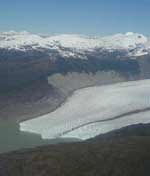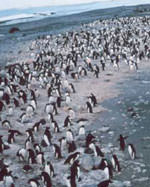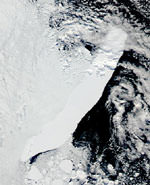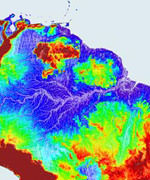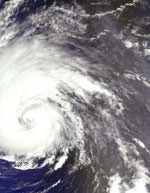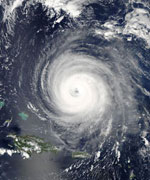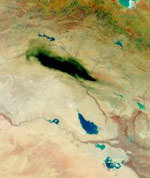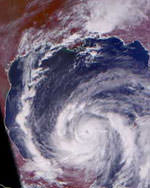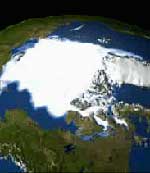
Image credit: NASA
New images of shrinking sea ice may provide further evidence that the Earth is undergoing significant climate change. NASA scientists compared images of arctic sea ice since 1981 and have measured that it’s shrinking by an average of 9% per decade – summer sea ice in 2002 was a record low levels. The loss of ice could accelerate global warming because liquid water absorbs sunlight instead of reflecting it like ice.
Recently observed change in Arctic temperatures and sea ice cover may be a harbinger of global climate changes to come, according to a recent NASA study. Satellite data — the unique view from space — are allowing researchers to more clearly see Arctic changes and develop an improved understanding of the possible effect on climate worldwide.
The Arctic warming study, appearing in the November 1 issue of the American Meteorological Society’s Journal of Climate, shows that compared to the 1980s, most of the Arctic warmed significantly over the last decade, with the biggest temperature increases occurring over North America.
“The new study is unique in that, previously, similar studies made use of data from very few points scattered in various parts of the Arctic region,” said the study’s author, Dr. Josefino C. Comiso, senior research scientist at NASA’s Goddard Space Flight Center, Greenbelt, Md. “These results show the large spatial variability in the trends that only satellite data can provide.” Comiso used surface temperatures taken from satellites between 1981 and 2001 in his study.
The result has direct connections to NASA-funded studies conducted last year that found perennial, or year-round, sea ice in the Arctic is declining at a rate of nine percent per decade and that in 2002 summer sea ice was at record low levels. Early results indicate this persisted in 2003.
Researchers have suspected loss of Arctic sea ice may be caused by changing atmospheric pressure patterns over the Arctic that move sea ice around, and by warming Arctic temperatures that result from greenhouse gas buildup in the atmosphere.
Warming trends like those found in these studies could greatly affect ocean processes, which, in turn, impact Arctic and global climate, said Michael Steele, senior oceanographer at the University of Washington, Seattle. Liquid water absorbs the Sun’s energy rather than reflecting it into the atmosphere the way ice does. As the oceans warm and ice thins, more solar energy is absorbed by the water, creating positive feedbacks that lead to further melting. Such dynamics can change the temperature of ocean layers, impact ocean circulation and salinity, change marine habitats, and widen shipping lanes, Steele said.
In related NASA-funded research that observes perennial sea-ice trends, Mark C. Serreze, a scientist at the University of Colorado, Boulder, found that in 2002 the extent of Arctic summer sea ice reached the lowest level in the satellite record, suggesting this is part of a trend. “It appears that the summer 2003 — if it does not set a new record — will be very close to the levels of last year,” Serreze said. “In other words, we have not seen a recovery; we really see we are reinforcing that general downward trend.” A paper on this topic is forthcoming.
According to Comiso’s study, when compared to longer term ground-based surface temperature data, the rate of warming in the Arctic over the last 20 years is eight times the rate of warming over the last 100 years.
Comiso’s study also finds temperature trends vary by region and season. While warming is prevalent over most of the Arctic, some areas, such as Greenland, appear to be cooling. Springtimes arrived earlier and were warmer, and warmer autumns lasted longer, the study found. Most importantly, temperatures increased on average by 1.22 degrees Celsius per decade over sea ice during Arctic summer. The summer warming and lengthened melt season appears to be affecting the volume and extent of permanent sea ice. Annual trends, which were not quite as strong, ranged from a warming of 1.06 degrees Celsius over North America to a cooling of .09 degrees Celsius in Greenland.
If the high latitudes warm, and sea ice extent declines, thawing Arctic soils may release significant amounts of carbon dioxide and methane now trapped in permafrost, and slightly warmer ocean water could release frozen natural gases in the sea floor, all of which act as greenhouse gases in the atmosphere, said David Rind, a senior researcher at NASA’s Goddard Institute of Space Studies, New York. “These feedbacks are complex and we are working to understand them,” he added.
The surface temperature records covering from 1981 to 2001 were obtained through thermal infrared data from National Oceanic and Atmospheric Administration satellites. The studies were funded by NASA’s Earth Science Enterprise, which is dedicated to understanding the Earth as an integrated system and applying Earth System Science to improve prediction of climate, weather and natural hazards using the unique vantage point of space.
Original Source: NASA News Release

